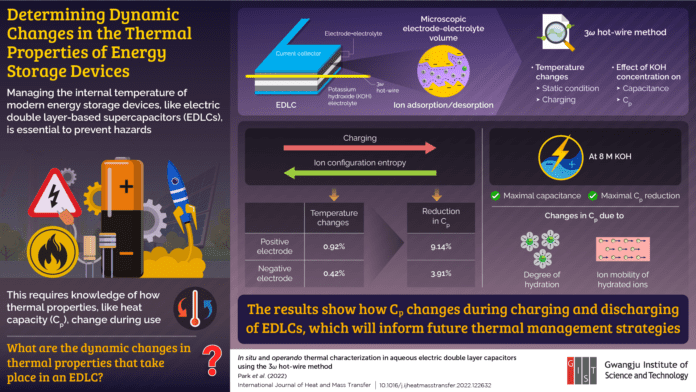Researchers at the GIST Uncover the Key to Safer Energy Storage Devices
The scientists elucidate critical changes in the thermal properties of energy storage devices during operation, paving the way towards better thermal management
Effectively managing the thermal properties of energy storage devices is the key to avoiding thermal runaway and ensuring safety. Recently, scientists from the Gwangju Institute of Science and Technology uncovered key changes to the thermal properties of electric double-layer capacitors during charging and discharging, which will help inform future thermal management strategies.
Modern energy storage devices, such as supercapacitors and batteries, have highly temperature-dependent performance. If a device get too hot, it become susceptible to ‘thermal runaway.’ Thermal runaway—or uncontrolled overheating—can ultimately result in explosions or fires. Adopting a well-informed thermal management strategy is necessary for the stable and safe operation of devices. To do this, it is important to understand how certain thermal properties, like heat capacity (Cp), dynamically change during charging and discharging.
Recently, researchers from the Gwangju Institute of Science and Technology investigated the thermal properties of electric double-layer capacitors (EDLCs)—a type of supercapacitor having high power and long life—for a technical foundation in thermal measurement and revealed significant information. “Using the 3ω hot-wire method, we were able to measure the change in heat capacity of EDLCs in real-time in a microscopic electrode-electrolyte volume, which is an active site for the adsorption and desorption of ions,” explains Prof. Jae Hun Seol, who led the study. The study was made available online on 5 February 2022 and will be published in Volume 188, Issue 122632 of International Journal of Heat and Mass Transfer on 1 June 2022.
The research team conducted experiments both in situ (under static conditions) and operando (during charging). They found that the temperatures of the positive and negative electrodes changed by 0.92% and 0.42% during charging, which corresponded to 9.14% and 3.91% reductions in their respective Cp. “According to thermodynamic theory, the ionic configuration entropy (a measure of randomness) of a system decreases during adsorption, i.e., charging. This also affects the free energy of the system. Together, this leads to a decrease in Cp,” explains Prof. Seol.
The team also varied the concentration of the electrolyte, potassium hydroxide, to see how it affected EDLC performance. They found that the EDLC displayed maximum capacitance and Cp reduction when the electrolyte concentration was 8 M. They attributed this to variations in the degree of hydration of ions and their ionic mobility.
“An important aspect of this study is that charging and discharging also alters Cp of EDLCs,” says Prof. Seol. “These findings will extend our understanding of the underlying thermal physics of EDLCs.”
Indeed, these results can be considered a major step towards future effective thermal management strategies, which will create safer and more reliable energy storage devices.
***
Reference
Title of original paper: In situ and operando thermal characterization in aqueous electric double layer capacitors using the 3ω hot-wire methodJournal: International Journal of Heat and Mass TransferDOI: https://doi.org/10.1016/j.ijheatmasstransfer.2022.122632
About the Gwangju Institute of Science and Technology (GIST)
The Gwangju Institute of Science and Technology (GIST) was founded in 1993 by the Korean government as a research-oriented graduate school to help ensure Korea’s continued economic growth and prosperity by developing advanced science and technology with an emphasis on collaboration with the international community. Since that time, GIST has pioneered a highly regarded undergraduate science curriculum in 2010 that has become a model for other science universities in Korea. To learn more about GIST and its exciting opportunities for researchers and students alike, please visit: http://www.gist.ac.kr/.
About the author
Jae Hun Seol is an Associate Professor of Department of Mechanical Engineering at the Gwangju Institute of Science and Technology (GIST) in South Korea. In 2009, he received his Ph.D. in Mechanical Engineering from the University of Texas at Austin. Seol’s group has interests in micro- and nanoscale heat transport phenomena and pursues thermal energy solutions in a broad spectrum of applications, including thermal management and energy conversion, based on expertise in thermal characterization and numerical analysis. Currently, his group is trying to develop novel approaches to achieve a breakthrough on thermal issues currently facing modern technological devices.
Help keep news FREE for our readers
Supporting your local community newspaper/online news outlet is crucial now more than ever. If you believe in independent journalism, then consider making a valuable contribution by making a one-time or monthly donation. We operate in rural areas where providing unbiased news can be challenging. Read More About Supporting The West Wales Chronicle


























